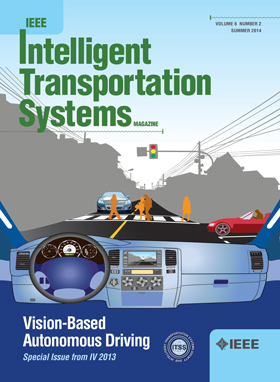基于面部表情和耳-脑电图的多模态驾驶员困倦检测及轻量自动去噪网络
IF 8.4
1区 工程技术
Q1 ENGINEERING, CIVIL
IEEE Transactions on Intelligent Transportation Systems
Pub Date : 2025-04-21
DOI:10.1109/TITS.2025.3559098
引用次数: 0
摘要
将计算机视觉与生理分析相结合用于驾驶员困倦检测(DDD)是一项很有前途的技术,可以准确识别驾驶时的困倦状态,从而预防潜在的危险事故。本研究提出了一种基于深度神经网络的多模态DDD系统,该系统将基于计算机视觉的人脸表情分析与脑电图数据分析相结合。主要贡献包括:1)为DDD系统提供了全面的硬件、固件和软件设计,以获取耳后脑电图信号,而不是传统的头皮脑电图,因为它们的便利性和实用性;2)提出了一种功能强大、重量轻的基于gan的脑电信号自动去噪方法,以消除信号采集过程中对所得结果质量有显著影响的伪影;3)将EEG分析与基于计算机视觉的人脸表情识别相结合,构建多模态DDD网络,提高驾驶员在交通过程中困倦状态的监测和早期检测能力。该研究在时域和谱域采用相对均方根误差(RRMSE)来定量评估所提出的方法在去除伪影方面的性能。提出的基于gan的自动去噪网络优于其他可比较的方法,RRMSE(时间)为0.210,RRMSE(谱)为0.161。基于gan的多模态自动去噪模型在5个评价指标上均优于其他不同去噪方法的模型,准确率为95.33%,特异性为95.48%,灵敏度为95.17%,精度为95.47%,f1评分为95.32%。实验结果证明了所提出的DDD系统的实用性和可行性。本文章由计算机程序翻译,如有差异,请以英文原文为准。
Multimodal Driver Drowsiness Detection Using Facial Expressions and Ear-EEGs With a Lightweight Auto-Denoising Network
Integrating computer vision and physiological analysis in driver drowsiness detection (DDD) is a promising technology for accurately identifying drowsy states while driving, thereby preventing potentially dangerous accidents. This study proposes a multimodal DDD system with a deep neural network that combines computer vision-based face expression analysis and electroencephalogram (EEG) data analysis. Key contributions include: 1) providing a comprehensive hardware, firmware, and software design for the DDD system to acquire behind-the-ear (BTE) EEG signals, rather than conventional scalp EEGs, due to their convenience and practicality; 2) proposing a powerful and lightweight GAN-based auto-denoising method to eliminate artifacts from EEG signals during signal acquisition, significantly influencing the quality of the obtained result; 3) developing a multimodal DDD network by combining EEG analysis and computer vision-based face expression identification to improve performance in monitoring and early detection of the driver’s drowsiness while engaging in traffic. The study employs the relative root mean squared error (RRMSE) in both temporal and spectral domains to quantitatively assess the performance of the proposed approaches in artifact removal. The proposed GAN-based auto-denoising network outperforms other comparable approaches, with an RRMSE (temporal) of 0.210 and RRMSE (spectral) of 0.161. The proposed trained multimodal model with GAN-based auto-denoising is superior to other models with different denoising approaches in driver drowsiness detection across all five-evaluation metrics, with an accuracy of 95.33%, specificity of 95.48%, sensitivity of 95.17%, precision of 95.47%, and an F1-score of 95.32%. The experimental results demonstrate the practicality and feasibility of our proposed DDD system.
求助全文
通过发布文献求助,成功后即可免费获取论文全文。
去求助
来源期刊

IEEE Transactions on Intelligent Transportation Systems
工程技术-工程:电子与电气
CiteScore
14.80
自引率
12.90%
发文量
1872
审稿时长
7.5 months
期刊介绍:
The theoretical, experimental and operational aspects of electrical and electronics engineering and information technologies as applied to Intelligent Transportation Systems (ITS). Intelligent Transportation Systems are defined as those systems utilizing synergistic technologies and systems engineering concepts to develop and improve transportation systems of all kinds. The scope of this interdisciplinary activity includes the promotion, consolidation and coordination of ITS technical activities among IEEE entities, and providing a focus for cooperative activities, both internally and externally.
 求助内容:
求助内容: 应助结果提醒方式:
应助结果提醒方式:


